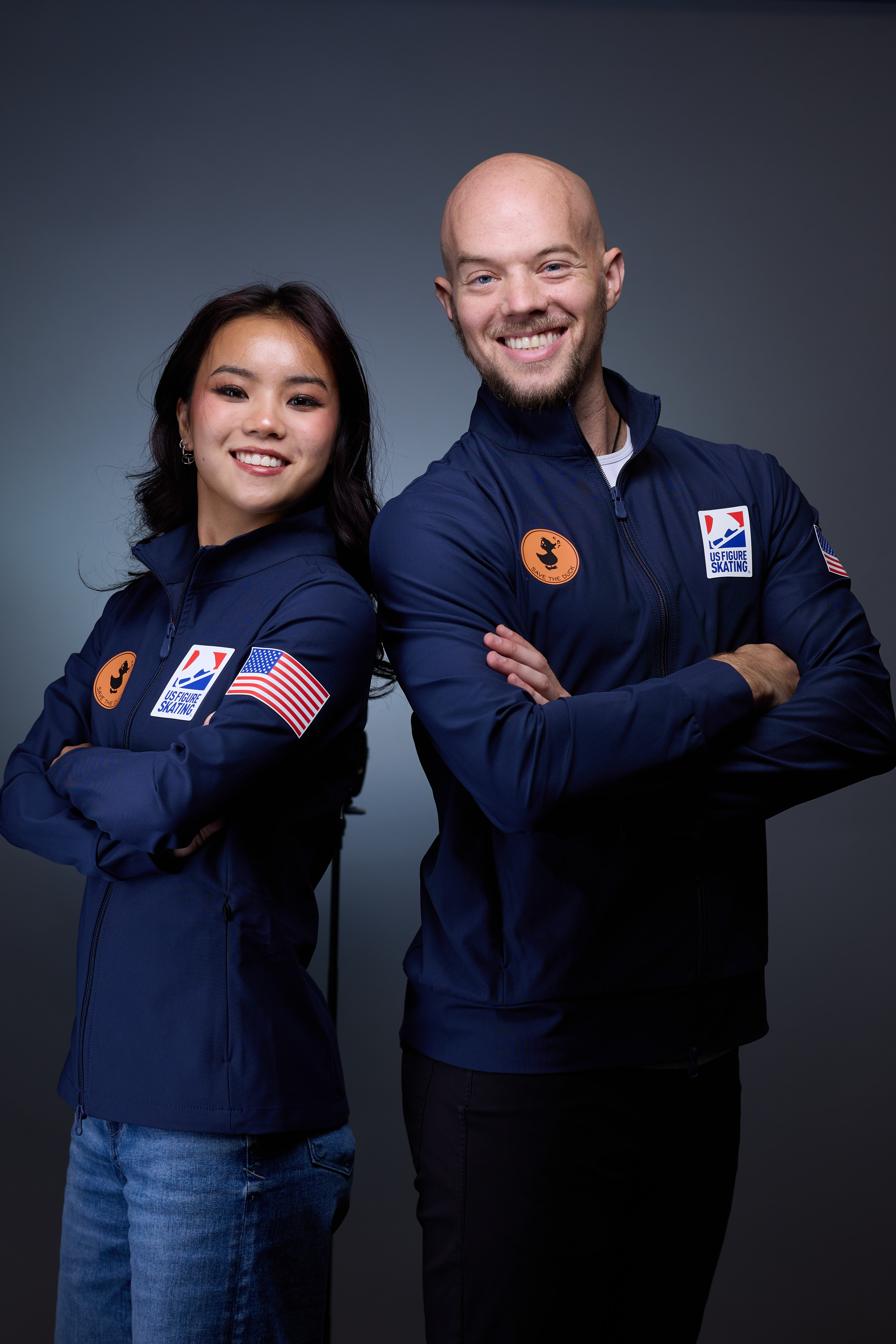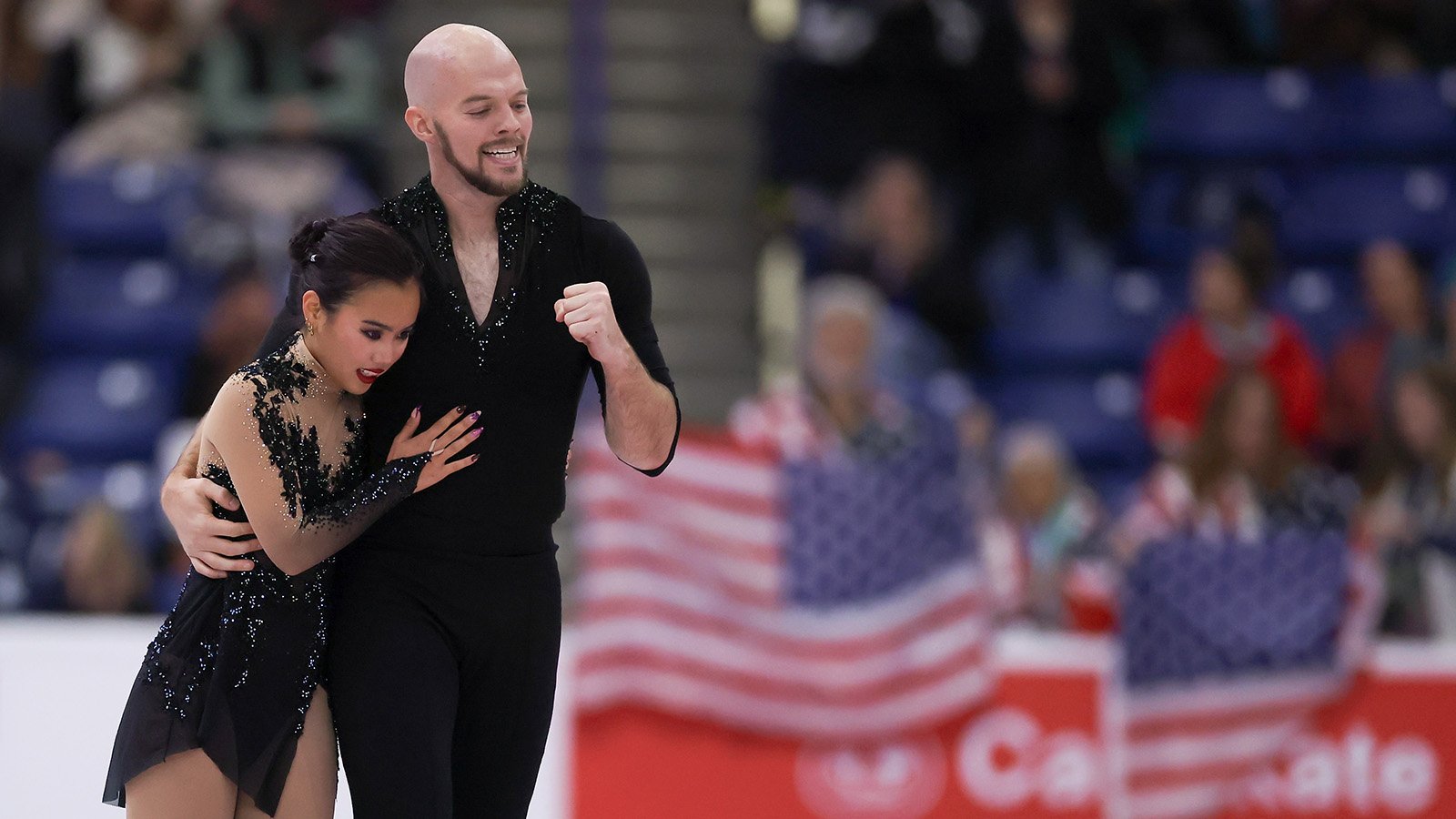Above: Ellie Kam and Danny O'Shea triumphantly leave the ice after a stellar free skate at Skate Canada International. Photo by Getty Images
By Mimi McKinnis
Kintsugi is the Japanese art of repairing broken pottery by mending the cracks with gold, silver, or other precious medals. This “rejoining” technique celebrates the long-term picture, and views breakage and repair as part of the journey rather than something to be concealed. The result is a beautiful, unique, and even stronger piece than before it was broken. In addition to serving as inspiration for Ellie Kam and Danny O’Shea’s short program costumes, it’s beginning to serve as a metaphor for their 2025–26 season.
“It’s not easy,” O’Shea said. “It seems like a simple concept: Trust the process and focus on the joy. But day to day, we take turns struggling. It’s hard mentally to stay focused on that process and not on the emotional rollercoaster or the physical things that get in the way. It’s hard to tune out the noise of the Olympic year. But by refocusing on the process every time something comes up, we’re able to overcome the challenges. Hardship is inevitable … But we find a way to come back together.”

Photo by Janet Liu
After last year’s breakout season, which included two Grand Prix Series medals and a trip to the Grand Prix Final (just the eighth U.S. pairs team to do so), to say their offseason had some challenges is an understatement. While surgery to repair a sports hernia O’Shea struggled with all last year was a planned part of their season strategy, a second major surgery — one that required two plates and 11 screws to repair O’Shea’s broken foot — was not. Neither was a concussion that kept Kam off the ice for an additional month just weeks after O’Shea’s return.
“It was a very strange and delayed offseason, even with the parts that we knew about,” their coach, Drew Meekins, said. “But we made it a part of our strategy. I think our focus has been sticking to the plan, trusting it, and putting in the work to get where we need to be by the time that we need to be there. And because of that process, we know that we can handle it when different things come up.”
With the additional healing time required, the 2024 U.S. champions couldn’t compete for the first time or even get their programs in front of any audience, until the Trialeti Trophy in mid-October. Such a delay could rattle any team beginning their Olympic campaign, but, like Kintsugi, Kam and O’Shea focused on the long-term picture, not the unexpected pieces. Just weeks after a fifth-place finish there, the duo rallied to claim their third-career Grand Prix Series medal at Skate Canada — a feat that began to rejoin the pieces of their offseason with bronze.
“We didn’t skate at [U.S.Figure Skating] Champs Camp. We didn’t skate at John Nicks [Pairs Challenge International]. But we had to get out there somewhere,” O’Shea said. “Then you look at what we were able to do at Skate Canada, and we can see that Georgia was a necessary part of this season. And by choosing not to let anything be more than a part of the process, we’re able to keep training and grow through every experience.”
Now, with their second assignment (Finlandia Trophy) just a few days away, the Colorado Springs-based pair, currently ranked sixth in the world, is more determined than ever to catch up on the offseason training they missed.
“As we tried to get the train moving before Georgia, we didn’t have that training mileage under our belt yet,” Kam said. “We were trying to take baby steps into running normal programs every day. In the past few weeks since then, we’re finally able to get to work — down to the nitty gritty training day in and day out.”
“Now we’re still in the building phase of the season,” O’Shea said, “which is weird, because we just finished a Grand Prix. I think it’s a privileged place to be — knowing that we can medal, even with a lot of work still to do. These programs don’t feel comfortable yet. We asked our choreographers, Drew and Marie-France (Dubreuil), to really challenge us, and that makes this a long process. There’s still a lot of mental work going on for things that will eventually become second nature. That comfort will allow us to perform a little bit more and better focus on the elements. I’m excited for us to hit that stride. Until then, it’s back to more really hard work.”
After everything, as the countdown to Milano-Cortina marches on, Kam and O’Shea remain focused on delivering stand-out performances that inspire progress in their discipline, rejoining the pieces to create a unique, cohesive product at season’s end — a product even stronger than before its setbacks.
“Our process ever since they became a team has been the same,” Meekins said. “We have goals, of course. We talk about them and we set them. It’s important. But we really prioritize the process. That means a mindset of going out and competing — performing programs that make them feel proud and feel in line with what they’re capable of. That’s what our conversations are about. It’s not about one obstacle, one end, or any singular thing. Every piece, every victory, every setback and step forward is a way to keep improving and stay true to a growth mindset of pushing the envelope. We want to be true to ourselves and find joy in what we do.”



